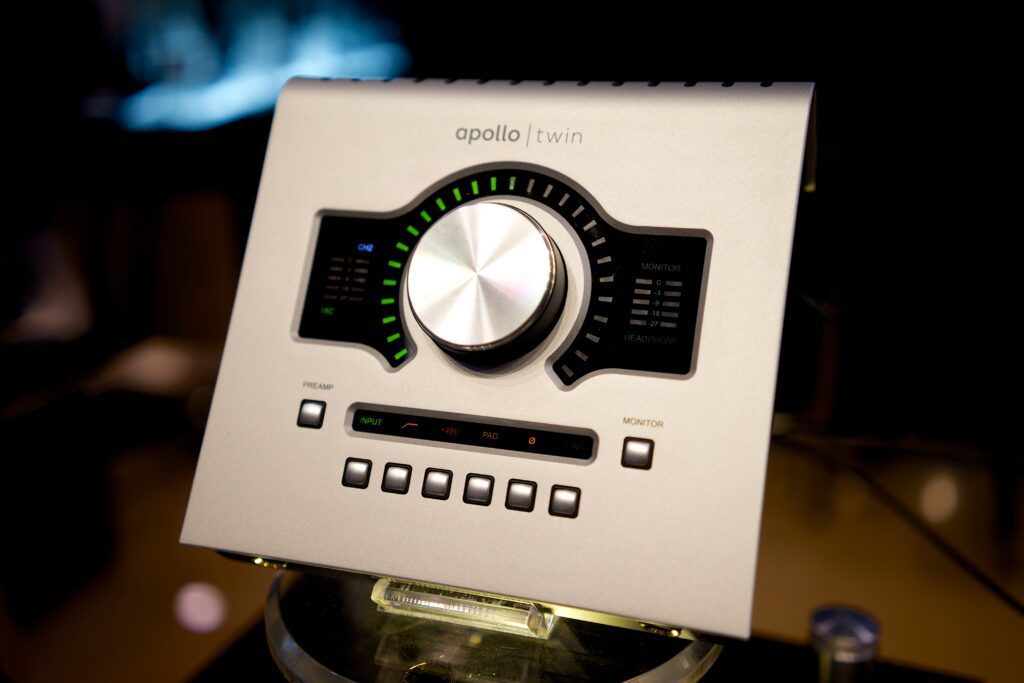A Thunderbolt audio interface is a hardware device that connects to a computer using Thunderbolt technology. Thunderbolt is a high-speed interface technology allowing bi-directional data transfer and video output. Intel developed Thunderbolt technology, and it first introduced it in 2011.
Thunderbolt audio interfaces are popular among music producers and audio professionals due to their high speed and low latency. They are designed to handle large amounts of audio data and provide high-quality sound output. Thunderbolt audio interfaces are typically more expensive than USB and often used in medium to large-sized recording studios.
Thunderbolt audio interfaces are an essential component of any recording setup. They allow for high-quality audio recording and playback and provide a reliable and fast connection to a computer. In this article, we will explore what a Thunderbolt audio interface is, how it works, and some of the best ones currently on the market.
Table of Contents
- What is a Thunderbolt Audio Interface?
- How Does a Thunderbolt Audio Interface Work?
- Benefits of Using a Thunderbolt Audio Interface
- Features to Look for in a Thunderbolt Audio Interface
- Compatibility with Other Devices
- List of Brands and Models of Thunderbolt Audio Interfaces
- Conclusion

What is a Thunderbolt Audio Interface?
A Thunderbolt audio interface is a type of audio interface that uses Thunderbolt technology to connect to a computer. Thunderbolt is a high-speed data transfer technology developed by Intel in collaboration with Apple. Thunderbolt technology allows lightning-fast data transfer rates and low latency, making it ideal for audio and video applications.
Thunderbolt audio interfaces are designed to provide high-quality audio recording and playback capabilities for professional audio engineers and musicians. They typically feature high-quality analog-to-digital converters (ADCs), digital-to-analog converters (DACs), preamps, and other audio processing capabilities.
Thunderbolt audio interfaces are available in various sizes and configurations, from small, portable units with just a few inputs and outputs to large, rack-mounted units with dozens of inputs and outputs and extensive processing capabilities. Some Thunderbolt audio interfaces also include built-in DSP processing, allowing for real-time effects processing and other audio enhancements.
How Does a Thunderbolt Audio Interface Work?
Thunderbolt is a high-speed data transfer technology that allows for the transfer of large amounts of data at high speeds.
Thunderbolt audio interfaces work by connecting to your computer using a Thunderbolt cable. Once connected, the audio interface can transfer audio data to and from your computer at high speeds, allowing for low-latency recording and playback.
Thunderbolt audio interfaces also often come with DSP processing capabilities, meaning they can process audio data directly on the audio interface rather than relying on your computer’s CPU. This can help reduce latency and improve overall performance.
Ensuring your computer has a Thunderbolt port is important when using a Thunderbolt audio interface. If your computer doesn’t have a Thunderbolt port, you may need to use an adapter to connect your audio interface to your computer.
Overall, Thunderbolt audio interfaces provide a high-speed, low-latency way to transfer audio data between your computer and your audio interface, making them a popular choice for professional audio recording and production.
Benefits of Using a Thunderbolt Audio Interface
Thunderbolt is a high-speed data transfer protocol developed by Intel in collaboration with Apple. Thunderbolt audio interfaces are becoming increasingly popular among professional audio engineers and music producers because of the following benefits:
- Low Latency: Thunderbolt offers low latency performance, meaning you can record and monitor audio with minimal delay. This is especially important for musicians who must hear themselves in real time while recording.
- High Bandwidth: Thunderbolt has a high bandwidth, so you can quickly transfer large amounts of data. This is important for recording and mixing high-resolution audio files.
- Daisy-Chaining: Thunderbolt lets you daisy-chain multiple devices together, connecting several Thunderbolt audio interfaces to your computer without additional ports. This is useful for larger recording studios that require multiple audio interfaces.
- Customization: Most Thunderbolt audio interfaces have a control app that allows you to customize the signal routing within the interface. This means you can create custom mixes and monitor different sources while recording.
- Compatibility: Thunderbolt is compatible with Mac and Windows computers, which means you can use a Thunderbolt audio interface with a wide range of computers and digital audio workstations (DAWs).
Overall, Thunderbolt audio interfaces offer a range of benefits that make them a popular choice among professional audio engineers and music producers. They offer low latency performance, high bandwidth, daisy-chaining capabilities, customization options, and compatibility with various computers and DAWs.
Features to Look for in a Thunderbolt Audio Interface
Thunderbolt audio interfaces come in many shapes and sizes, with varying features and capabilities. Here are a few key features to consider when choosing a Thunderbolt audio interface:
- Number of inputs and outputs: One of the most important factors to consider when choosing a Thunderbolt audio interface. The number of inputs and outputs you need will depend on your specific recording needs. If you’re recording a full band, you’ll need more inputs than if you’re recording a solo artist.
- Preamps: Preamps are an important part of any audio interface. They amplify the signal from your microphone or instrument and can greatly impact the quality of your recordings. Look for an interface with high-quality preamps that can provide clean, transparent sound.
- Sample rate and bit depth: Sample rate and bit depth are important factors affecting your recordings’ quality. Look for an interface with a high sample rate and bit depth to ensure your recordings sound as good as possible.
- Compatibility: Make sure the Thunderbolt audio interface you choose is compatible with your computer and recording software. Some interfaces may only work with certain operating systems or recording programs.
- Latency: Latency is the delay between when you play or sing a note and hear it through your headphones. Look for an interface with low latency to ensure you can play and record with minimal delay.
Choosing the right Thunderbolt audio interface will depend on your specific needs and budget. Consider the above features and any additional features that may be important to you, such as built-in effects or MIDI connectivity. With the right interface, you can capture high-quality recordings that sound great.
Compatibility with Other Devices
One of the main advantages of a Thunderbolt audio interface is its compatibility with other devices. Thunderbolt technology is designed to work with a wide range of devices, including computers, laptops, and tablets. Thunderbolt audio interfaces can be connected to Macs, PCs, and other devices that support Thunderbolt connectivity.
Thunderbolt audio interfaces are also compatible with various audio equipment, including microphones, guitars, and keyboards. Many Thunderbolt audio interfaces come with multiple inputs and outputs, allowing you to connect multiple devices simultaneously. This makes it easy to record multiple tracks simultaneously or connect to a mixing console or other audio equipment.
Regarding compatibility with software, Thunderbolt audio interfaces are designed to work with a wide range of digital audio workstations (DAWs) and other audio software. Many Thunderbolt audio interfaces come with their software, which can control the interface and adjust settings such as input levels, sample rates, and buffer sizes.
It’s worth noting that Thunderbolt audio interfaces may not be compatible with older devices that do not support Thunderbolt connectivity. If you have an older computer or audio equipment that does not support Thunderbolt, you may need to use a different type of audio interface, such as a USB or FireWire interface.
List of Brands and Models of Thunderbolt Audio Interfaces
When choosing a Thunderbolt audio interface, it’s important to consider the different brands and models available. Here are some of the top brands and models of Thunderbolt audio interfaces:
Universal Audio Apollo Twin MKII
This is one of the best-known and most popular Thunderbolt audio interfaces on the market. It includes two Unison preamps, high-end A/D and D/A converters, low latency performance, UAD plug-ins, and more.
Presonus Quantum 2
The Presonus Quantum 2 is a powerful Thunderbolt audio interface with 8 mic preamps, 24-bit 192 kHz resolution, MIDI I/O, monitor mixing controls, and onboard effects. It also includes the award-winning Studio One recording software.
Antelope Audio Discrete 4 Synergy Core
The Antelope Audio Discrete 4 Synergy Core is a powerful Thunderbolt audio interface with 4 mic preamps and built-in DSP for real-time effects processing. It also features high-quality converters, ADAT I/O, MIDI I/O, and more.
These are just some of the top brands and models of Thunderbolt audio interfaces available today. With so many options, it can be difficult to pick the right one. Be sure to research and consider all your needs before making a decision. Investing in a quality Thunderbolt audio interface can improve sound quality, reliability, and ease of use.
Conclusion
Thunderbolt audio interfaces provide lightning-fast speeds and incredibly low latency compared to USB audio interfaces. They are ideal for professional musicians, audio engineers, and producers who require high-quality audio recordings with minimal latency. Thunderbolt audio interfaces are compatible with Mac and Windows operating systems and are available in various sizes and configurations.
When choosing a Thunderbolt audio interface, it is essential to consider your specific needs and budget. Some Thunderbolt audio interfaces offer more inputs and outputs, while others prioritize portability and compactness. It’s also important to ensure that your computer has a Thunderbolt port and is compatible with your desired Thunderbolt audio interface.
Thunderbolt audio interfaces are reliable and efficient for those requiring high-quality audio recordings. With faster transfer speeds and lower latency, Thunderbolt audio interfaces are a must-have for any professional recording studio or on-location recording setup.
- Review of the ALABS IRON MINI-WL: A Powerhouse Wireless Microphone - October 4, 2023
- What is a Saturator in Music Production: A Brief Explanation - May 11, 2023
- What Are Rotary DJ Mixers? An Overview - May 11, 2023
SoundStudiomagic.com is a participant in the Amazon Services LLC Associates Program, an affiliate advertising program designed to provide a means for sites to earn advertising fees by advertising and linking to Amazon.com. We also participate in other affiliate programs which compensate us for referring traffic.




